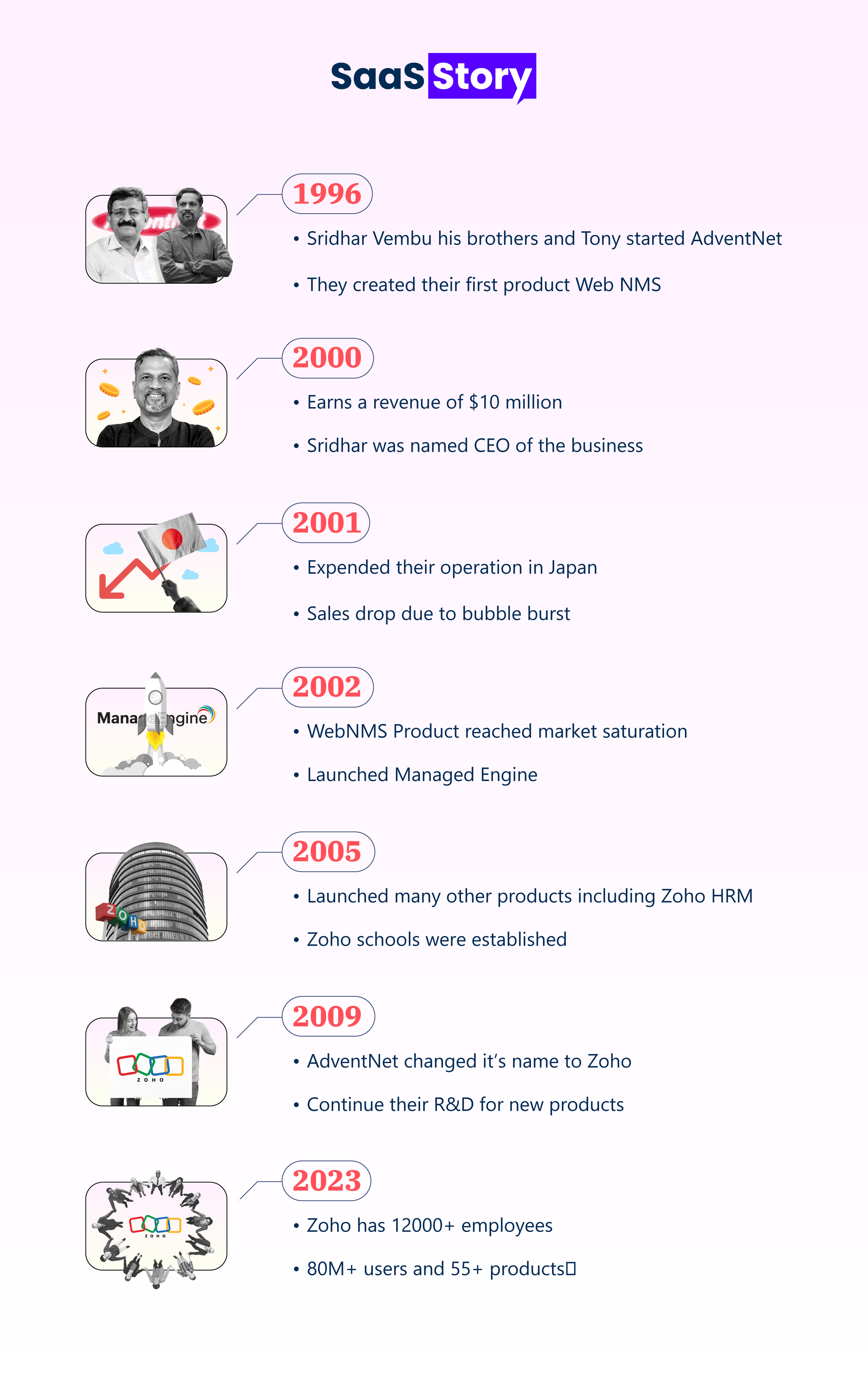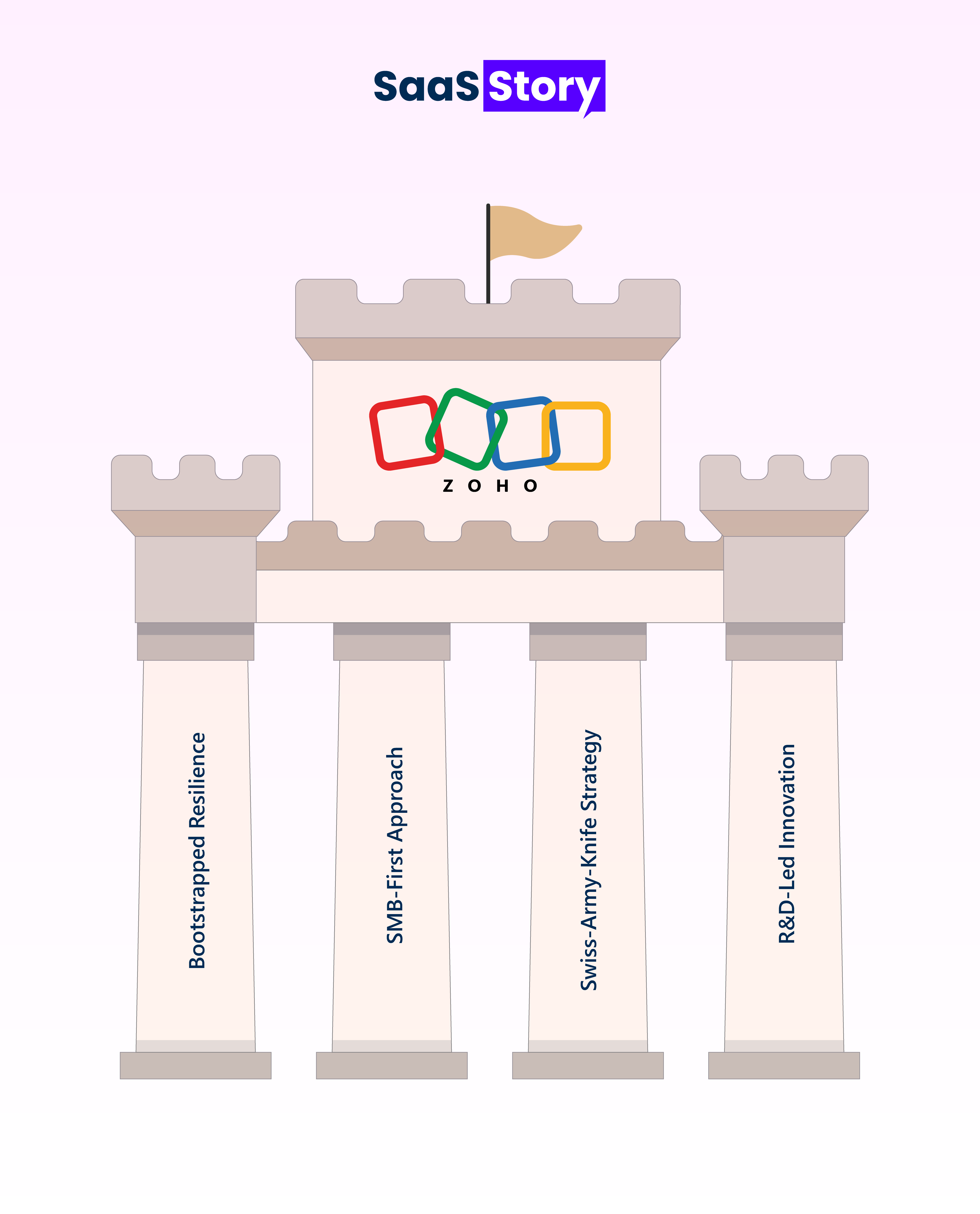India’s Silent SaaS Giant: Zoho’s Success Journey

In the humble outskirts of Tenkasi, far from the glazed skyscrapers of Bengaluru and Silicon Valley, a quiet revolution was stirring up. Sridhar Vembu, driven by the conviction to reverse the "brain drain" from small towns, was developing software that worked for people.
From its unpresuming beginnings in Chennai in 1996, Zoho grew into a billion-dollar SaaS powerhouse without any fanfare or a dime of external funding. It is now clocking over $1.4 billion in annual revenue, a 27% leap over $1.1 billion reported in 2023. All of this was achieved by entirely reinvesting the earnings.
Vembu’s journey proved that a global tech company can operate from a small town. Today, Zoho is a leading SaaS firm that offers everything from CRM to accounting tools. It serves more than 100 million users in over 180 countries worldwide, with a cloud software suite that spans CRM, finance, HR, and AI-driven business tools.
Guided by a vision deep-rooted in self-reliance and innovation, Zoho has become India’s understated, yet hard-hitting answer to the global SaaS giants. The brand has proved that the loudest players aren’t always the ones that lead.
Operating profitably from day one, Zoho has steadily grown its user base and revenue year after year. They have earned the trust of several global enterprises, from small businesses to Fortune 500 companies, all without outside funding.
Zoho has headquarters in Austin, Texas, with international headquarters in Chennai, India, and other offices in Canada, the UK, Germany, Japan, Singapore, Mexico, and more.
Zoho’s Humble Beginnings: Origins Rooted in Frugality and Vision

In 1996, when SaaS was a mere buzzword, Sridhar Vembu and Tony Thomas launched AdventNet from a tiny rented apartment in Chennai.
The goal was not glamorous but clear一to build a reliable network management software for enterprise-grade clients. They created their first product, WebNMS, a platform that enables the creation of network management solutions at very low costs and with quick implementation time.
Besides technical competence, what set the firm apart from its competitors was its philosophy and belief that real innovation grows best without the crutches of external capital. Every dollar earned was thoughtfully reinvested, every hire was deliberate, and every product launch was purposeful.
By 2000, AdventNet earned a revenue of $10 million, and most of it was reinvested in engineering, not marketing. This decision baffled many but strengthened their product-first philosophy.
In 2002, AdventNet launched ManageEngine, a suite of IT tools that quietly gained traction among enterprises globally. Then in 2005, sensing the SaaS wave before it was trendy, Vembu launched Zoho HRM, planting the seeds for what would become a global software ecosystem.
Vembu’s ethos of self-reliance meant no flashy product launches or hurried pivots to please investors and zero compromise on values.
When AdventNet evolved into Zoho in 2009, it did so quietly while carrying forward the culture of frugality, vision, and innovation. Zoho chose to grow organically rather than chasing hypervaluation. With these ethos, the company has built a strong foundation to withstand market swings while being humble enough to listen to its customers.
The Swiss-Army-Knife Strategy: Building a Complete Business Toolkit
Zoho functions like a Swiss army knife for SMEs and large corporations, packing over 55 tools into one affordable and fully-integrated suite. This all-in-one philosophy, referred to as the ‘Swiss Knife Approach,’ helps businesses avoid juggling multiple vendors, configurations, or bulky budgets.
From its early days, Vembu and his team focused on building a product suite rather than chasing one-hit products or scaling fast to attract venture capital. They prioritized CRM, finance, HR, productivity, and analytics, all under one roof. The goal was to offer businesses of every size access to world-class tools at an affordable price.
They intensely studied customer pain points and created applications that worked seamlessly together, eliminating bottlenecks and inefficiencies in work processes. Whether it was Zoho CRM or Zoho Books, each product was designed for usability and effortless integration. Zoho’s product catalog exceeds 50 products, covering everything from business intelligence and finance to sales and marketing.
They achieved this product expansion by investing entirely in engineering, whereas competitors focused on marketing and enterprise sales. The product-led growth allowed Zoho to exceed $1 billion in revenue. They used the freemium model to drive usage among SMBs. Later, they moved up to midmarket firms and enterprises.
Zoho was all about creating an interconnected ecosystem that felt intuitive, affordable, and built for businesses of every size.
As Vembu put it in a 2019 CXOTalk interview -
‘We are a cloud software company at one level, and we call ourselves the operating system for business. What’s different about Zoho is that we provide an end-to-end suite of software covering all aspects of business to our enterprise customers.’
This philosophy explains why Zoho was never positioned as just another SaaS vendor. At its core, Zoho was designed to enable companies to run seamlessly, whether they’re startups or Fortune 500 companies.
The Core Philosophy behind Zoho’s Growth
Zoho’s philosophy seems downright contrarian as it was built by questioning the conventional wisdom. Most startups usually burn cash to chase rapid valuations and boost their marketing efforts. However, Zoho didn’t depend on external funding and chose to grow on its terms through pure innovation and value addition to users.
Here are the deliberate choices they made -
- They chose self-sufficiency over speed.
Zoho bootstrapped its product expansion and stayed immune to investor pressures, an area where most startups struggle. They prioritized product depth over quarterly growth metrics. Embracing this philosophy enabled them to reach the billion-dollar mark without compromising their values and culture.
- They went for rural hiring over the conventional urban talent hunt.
Vembu built offices in rural India. Zoho focused on training engineers from scratch rather than competing for graduates from elite schools.
He proudly shares, ‘In years to come, 50% of our employees will work from smaller rural centers. We want to keep people rooted in their towns and villages, and provide world-class jobs in these places.’

15% of Zoho’s workforce is already from rural areas. He shares that they work with greater loyalty and cost 40% less than the urban hires.
- They focused on long-term vision, not short-term hype.
While their competitors like Salesforce, HubSpot, and Freshworks sought headlines, Zoho put all its energy into being stable and resilient. This helped them stay immune to the market downturns and industry slowdowns.
In FY23, Zoho saw a 30% increase in revenue despite the global slowdown in SaaS demand and increased costs that year.
Zoho has always chosen discipline over dependence and vision over valuation. This shaped their reputation globally, redefining what a global tech giant means.
Silent Confidence, Loud Global Impact
Zoho’s engineering-first approach yielded them profits while positioning them as a SaaS giant that has a global reach but is grounded in humility.
From its headquarters in Tamil Nadu and rural tech hubs to the global offices in the US and Singapore, Zoho serves over 100 million users worldwide. All this while remaining privately-owned and venture-capital free. The company continues to register debt-free profits, even amid the global SaaS turbulence.
Staying away from flashy PR, Zoho earned a global footprint through a customer-centric approach and innovation. They focused on understanding and addressing the customer pain points, making their products resonate with users who appreciate flexibility and reliability.
Competing in a cut-throat SaaS domain, Zoho has become the beacon of sustainable growth driven by a unique vision and unwavering commitment.
Zoho’s Moat: The Four Pillars of Competitive Advantage

Bootstrapped Resilience
Zoho built itself on independence—no external funding, no investor pressure. This autonomy has allowed the company to stay true to its vision, reinvest profits into innovation, and stave off the short-term volatility that often derails funded startups.
Swiss-Army-Knife Strategy
With over 55 interwoven tools, from CRM to HR to accounting, Zoho presents itself as a unified toolkit for business. This all-in-one philosophy appeals especially to SMBs, reducing vendor complexity and offering substantial cost advantages.
This simplified business operations, making Zoho more than just software. It has become a business infrastructure.
SMB-First Approach
Zoho’s focus on SMBs reflects a deep understanding of customer needs, with affordable, functional, and reliable software. Its flagship bundle, Zoho One, delivers enterprise-grade capabilities at a fraction of competing costs, winning loyalty without boasting vanity metrics. This earned them trust among SMBs.
R&D-Led Innovation
Innovation at Zoho is prioritized over everything else. Investing a considerable portion of revenue in R&D, Zoho builds tools from the ground up, replacing external dependencies with its own scalable, integrated alternatives.
Looking Ahead: The Future of Zoho and Indian SaaS
Zoho’s winning game revolves around the strategic choices and sustainable innovation they prioritized over flashy promotions and product launches. Here’s how Zoho continues to reshape the SaaS landscape.
Deepening India’s Role in the SaaS Growth Trajectory
Under the new leadership of Mani Vembu, Zoho is investing where growth potential is palpable. With digital transformation accelerating over the past decade, Zoho is betting on India emerging not only as a revenue engine but as a strategic innovation hub.
The AI Era
Zoho's move into AI isn't about buzz—it’s foundational. The company has launched its Zia LLM, featuring several scalable models, a toolbox of autonomous agents, and a builder platform (Agent Studio + Marketplace). These tools will power contextual automation and reduce reliance on external AI—signaling a shift toward homegrown intelligence.
Verticalization and Enterprise-Ready Platforms
Zoho is sharpening its focus on domain-specific platforms, targeting verticals like healthcare, BFSI, and real estate with tightly integrated solutions. Its enterprise pipeline is drawing strength from both tailored offerings and a partner-led distribution model. This shift is designed to reach and win larger deals in the complex SaaS business ecosystem.
Ethics, Privacy, and Trust as Competitive Currency
Beyond growth numbers, Zoho is betting on data privacy, transparency, and engineering openness.
Take Home Points: Zoho as a Blueprint for Sustainable SaaS
From building products patiently to challenging global giants without external funding, Zoho’s journey offers a blueprint to sustain in today’s growth-at-any-cost tech world. Its discipline, long-term vision, and refusal to compromise on values have proven that sustainable growth is possible.
For Indian startups, Zoho isn’t just another SaaS success story; it’s proof that businesses can build a globally admired technology from anywhere, without chasing the PR frills, and still win.
Subscribe to our newsletter.
Be the first to know - subscribe today

